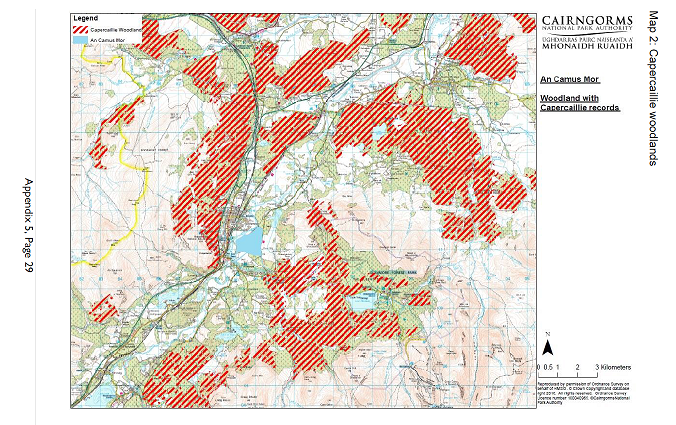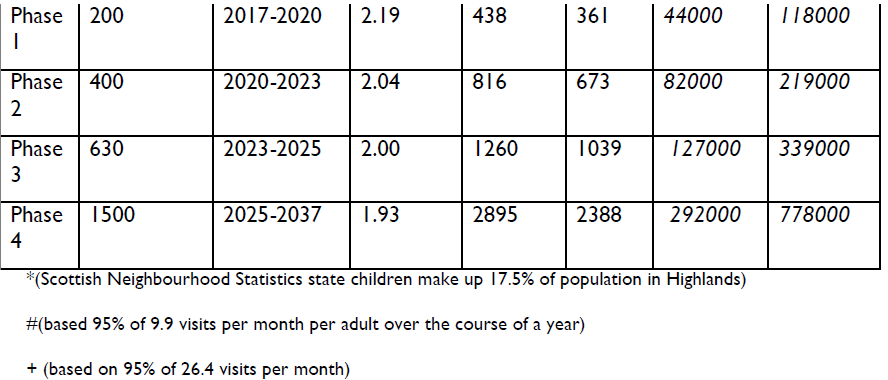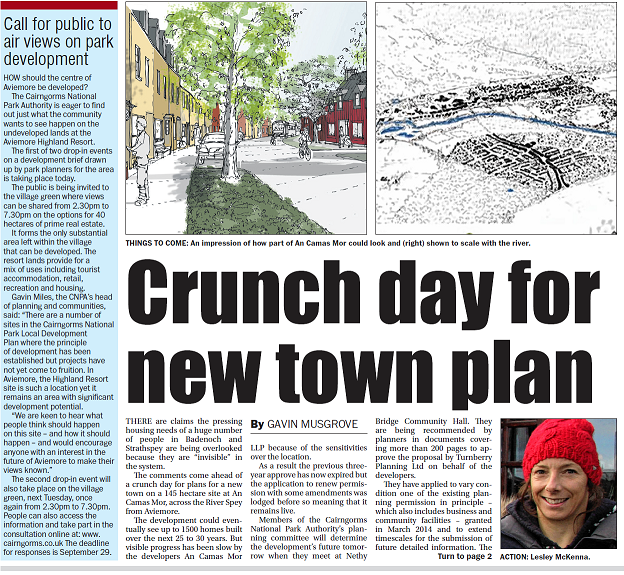
Following my post yesterday (see here), I thought it worth considering further the measures the Cairngorms National Park Authority claims will “mitigate” the impacts of the proposed An Camas Mor development and the implications for access on Speyside for both residents and visitors. It is now obvious from discussion with outdoor recreation interests, that any decision by the Park Authority to approve the amended planning application for the new town (An Camas Mor) on Rothiemurchus Estate will be open to legal challenge. The Park Authority have carried out no consultation with outdoor interests, or the public as a whole, on the draconian access restrictions which they announced this week for large tracts of the Cairngorms National Park. These so called mitigation measures are unworkable – leaving the Park open to legal challenge on conservation grounds – and unacceptable and need to be abandoned.
As a result I believe the CNPA Planning Committee on Friday either needs to reject the current planning application (which is to remove the Planning Condition which allows the CNPA to limit the development to 630 houses if it proves to have adverse impacts) or else conduct a full public consultation on the proposed “mitigation” measures before it takes a decision. Whatever the immediate decision, a full public consultation and inquiry is now needed into all the implications for this proposed huge housing and commercial development on Rothiemurchus in the heart of the Cairngorms.
The impact of the proposed An Camus Mor development on capercaillie
The central legal issues at stake at ACM concern the impact of the proposed development on capercaillie and the consequences for outdoor recreation. Capercaillie is not just a protected species once again facing extinction in Scotland, its also under both the previous and the recently approved new National Park Partnership Plan, the species which the CNPA has prioritised before all others. While other protected habitats and species are considered in the 240 page Habitats Regulations Assessment, the conclusion is that almost all “likely significant effects” of An Camus Mor will be on the capercaillie.
The reasoning behind this this, which I do not dispute, is that because there is evidence that capercaillie can be disturbed by outdoor recreation, if you plonk a new development with 1500 households at the heart of the woodlands most important for them, you will not just increase recreational use of those woodlands, you will increase recreational impacts on Capercaillie.
The first thing that is important here is what the increased levels of recreational use are likely to be. In its Habitats Regulations Appraisal the CNPA has stated that it is likely to be somewhere between 292,000 and 778,00 additional visits a year. The numbers are based on research on visits to the countryside from people living or visiting rural areas, the lower figure being the Scottish average and the higher one reflecting use by people most active in the outdoors.


The second and crucial point though is that the Habitats Regulations Assessment (HRA) says that for the mitigation measures to be effective the outcome required is that there will be NO overall increase in recreational visits to these woodlands. The implication, which is not spelled out in the HRA, is that even if there are even only 292,000 additional recreational visits to the countryside from people living or stay at ACM and even if only say half of these say are to woodlands important to capercaillie, is that other visitors would need to be reduced by 146,000 a year in order for the CNPA to achieve this outcome. That’s not far short of 500 fewer other visitors a day, whether existing residents of Aviemore or tourists.
It worth here dealing with the claim, that has been inserted at one point into the HRA, that “It is important to note that references in the required outcomes to no increase in recreational activity are specific to the residents of An Camas Mor alone”. This claim, that mitigation measures only apply to residents of ACM is conceptually incoherent, its belied by the contents of the rest of the HRA and is completely unenforceable. Here’s why:
- Increase the local population and there will be increased visits to the countryside which need to be offset elsewhere if the CNPA’s desired outcome is to be achieved. If the measures only apply to people staying at ACM, the only way that the required outcome – of not increasing overall visitor numbers could be achieved – would if the development was refused.
- Its clear from the wording of most of the outcomes which have been specified in the HRA, that they apply to everyone, not just people staying at ACM

Extract from the outcomes proposed for Glenmore
- Lastly, its clearly impossible for the CNPA or anyone else for that matter to identify which of the people walking, cycling, skiing or wildlife watching in the woods are from ACM and which are not. In other words almost all of the measures – apart from those being applied to the ACM site and the proposed reduction in car parking charges to try and encourage ACM residents to go to Loch an Eileen, where there are no capercaillie, rather than say Loch Morlich – will apply to everyone, whether resident of ACM, Aviemore or a day visitor. Hence, the implications for outdoor recreation and access rights.
Will the measures being proposed achieve the outcomes set out by the CNPA?
The HRA proposes a number of different types of measure to prevent an overall increase in visitor numbers, including reducing the size of car parks and diverting people elsewhere. Some of these are welcome and should be applied whether or not ACM goes ahead, for example the creation of new paths at Pityoulish and alternative places for dogwalking, because they improve current access provision and have no negative implications for access rights. In fact, they could usefully be added to the Cairngorm and Glenmore Strategy approved last year.
Nowhere in the HRA, however, does the CNPA analyse the individual impact of the measures it is proposing, either on access rights or on visitor numbers. So, for example, while the HRA states that the following car parks in Glenmore and the surrounding area will be closed or reduced, it does not say how many visitors use them:
- Prevention of informal parking at track and access entrances to Drumintoul lodge and
Atnahatnich farm - Restrict parking at Sled-dog centre, Badaguish road end and Milton end of Sluggan pass
- Complete blocking of old layby and timber loading area and other informal parking areas on Ski road
- Management of car parking along the B970 to ensure no increase in level of use especially at sensitive times of year and day. for example Dalnavert , Feshiebruach car park and Inshriach House informal car parking areas redesigned to limit capacity
Without knowing the predicted reduction in visits to woodland that will result from each of these measures, its impossible to tell if the measures as a whole will achieve CNPA’s desired outcome of successfully offsetting the predicted increase in visits arising from the ACM development. The claims in the Committee Report, therefore, that the mitigation measures outlined are sufficient to offset the impact of ACM and remove current constraints on its development are not based on any sound evidence.
The question then arises that, if the proposed measures are not sufficient to prevent any overall increase in visitor numbers (and one needs to remember here that the Cairngorm and Glenmore Strategy is based on predictions of significant growth in visitor numbers over the next few years) what work, what next? The HRA is quite clear:

The claims that byelaws are a last resort are worthless. The camping byelaws on east Loch Lomond were claimed, by that Park’s then chief executive Fiona Logan, as a last resort measure, which would not be used elsewhere and would only be needed temporary. Now the Park’s Director of Conservation, Simon Jones, openly states – although formally its not his decision to make – that the camping byelaws are here to stay.
Now, consider the legal implications. By law, before the CNPA could introduce byelaws to prevent an overall increase in visitor numbers it would have to, as the HRA says, conduct a public consultation. However, if the CNPA were to consult objectively, it would risk having any proposals to restrict access through byelaws being rejected by the public at large and would then find it impossible to mitigate the impacts of ACM. The only way it can claim that the current package of proposals to mitigate the impacts of ACM will work is if it has already in effect decided that it will bring in byelaws if necessary and then subverts the public consultation process, as did the Loch Lomond and Trossachs National Park Authority on their consultation on the the camping byelaws. This is why I think that in proposing these mitigation measures the CNPA is wide open to legal challenge.
The need for public consultation on the mitigation measures proposed to manage and limit access

The Habitat Regulations Assessment which proposes all these measures was produced under section 48 of the Habitats Regulations 1994. This requires the CNPA as Planning Authority, to consult with SNH. Sub-clause 3 reads:
(3) The competent authority shall for the purposes of the assessment consult the appropriate nature conservation body and have regard to any representations made by that body within such reasonable time as the authority may specify.
Strangely, however, the CNPA has made no reference in its report to the next sub-clause, 4:
(4) They shall also, if they consider it appropriate, take the opinion of the general public; and if they do so, they shall take such steps for that purpose as they consider appropriate.
So, under the Habitats Regulations, the CNPA could have decided to consult the public about their assessment and proposals to control and reduce access but have so far chosen not to do so. I think the CNPA need to explain why and on Friday, their Board, have the opportunity to put that right. The nub of that consultation should be whether the ACM development should be fully approved in principle (and the current planning condition which potentially restricts its size to 630 houses be removed) if this means that access rights might be restricted in future.
I think the answer to that question is clear, that if the implications of the revised planning application for ACM means increased restrictions on access on Speyside, then the revised planning application should be refused and the current planning condition, which allows the development to be restricted to 630 houses if it is having adverse impacts, should be retained. This is not just about the capercaillie, its about the rights of people in Scotland and whether these too are more important than those of developers.
An alternative explanation for what is going on is that the CNPA has no intention of removing access rights and while it knows that the proposed mitigation measures are both undesirable and unworkable, the HRA has been produced simply to meet its legal obligations and that – as with many other planning conditions attached to developments in the National Park – these simply won’t be enforced when the time comes. If this is the case, that too leaves the CNPA wide open to legal challenge.
The decision that the CNPA Planning Committee is being asked to make on Friday has far more potential consequences than those outlined in the Committee Report. The risk of legal challenge, whether on conservation or recreation grounds, will start next week but is likely to hang over the CNPA and the financiers behind the development for years. As stated in yesterday’s post, I believe the reason for this planning application to vary Planning Condition 1 was for the developers to guarantee their investment and future profits. Ironically the HRA, because so open to legal challenge, makes that investment look more, not less risky. The developers have opened the can of worms and put the desirability of ACM right back under the public spotlight. That can only be a good thing.